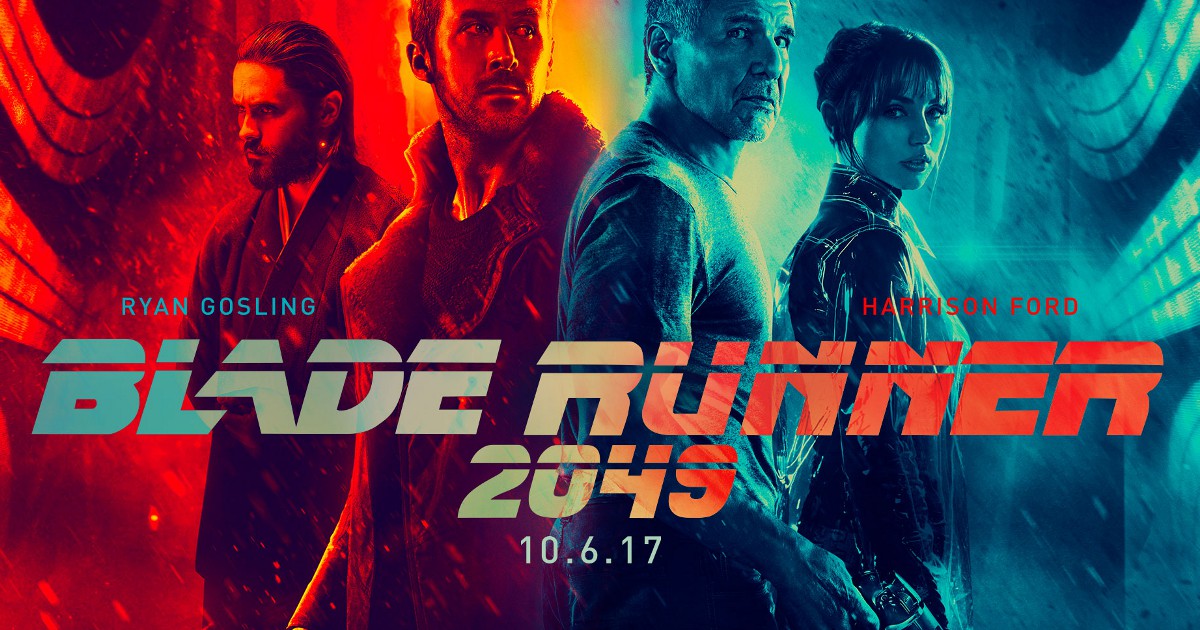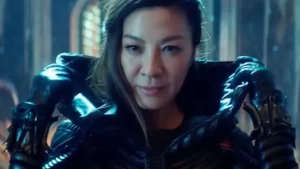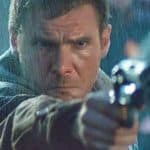A Long Time Coming
A Film Review of Blade Runner 2049
Blade Runner (now a film franchise) represents a corner of science fiction less interested in invading aliens, space travel and flashy technology and far more intrigued with using mankind’s ever increasing knowledge of science and its advancing application to further explore the nature of our very own humanity. Other forms of science fiction have delved into the realm of artificial life versus natural, bioorganic birth, but Blade Runner has been more mindful of the philosophical debate while presenting its story. Director Denis Villeneuve and writers Hampton Fancher and Michael Green (and of course, Philip K. Dick – author of the original source material) allow the philosophy to take the forefront as it maintains a consistent presence in just about every line of dialogue. Yes, the plot is being moved ahead, but every character the audience is introduced to has a say and a stake in determining the definition and meaning of life. Is existence the only criteria? Is survival enough? Does it mean to pursue life, liberty and happiness? What is life? What does any of this even mean?
Blade Runner 2049 continues asking the same types of questions posed in the original film of 1982 and Do Androids Dream of Electric Sheep? As before, this sequel doesn’t ask these questions directly to the audience, but subliminally through the context of yet another replicant-or-is-he (Joe, played by Ryan Gosling) experiencing an identity crisis. What I found most interesting was how this sequel was smart enough to stand a bit apart from its predecessor by adding an additional layer of thematic intelligence that compliments the definition/meaning of life question quite well: perception, illusion, reality and their relative equivalency. How I see all things define them a certain way which may or may not be objectively true, but they are the basis for reality as I see it. This is a basic concept that everyone in the audience should be able to comprehend which makes stepping into Joe, the blade runner’s shoes that much easier.
This semi-effective, retrofitted, cop drama is meant to simplify this grandiose “what if replicants were real” scenario to allow the audience to read into the dialogue, themes, characters and circumstances in order to self-determine. Engaging with the movie on this level represents the lion’s share of the fun because the immediate or superficial conflict that has our protagonist running around isn’t exactly what I would describe as riveting. There isn’t a lot of action. Every transition scene is drawn out to showcase the cityscapes and landscapes of futuristic California. Plot gaps abound. The pacing makes you feel every moment of a 2 hour and 44 minute film pass. And then there’s the “Gos-Look,” you know, Ryan Gosling’s deadpan, deer in the headlights, facial demeanor which is his signature as an actor. Sure, it is effective behavior for his character-who-is-possibly-human, but it sure gets old quick and works against an audience trying to like him. I love you: “Gos-Look.” I just stabbed you in the arm: “Gos-Look.” Let’s have some kinky sex: “Gos-Look.” The future of mankind’s entire existence hangs in the balance: “Gos-Look.”
|
Action Style |
A futuristic cop drama probably should have had more gun and fist fights, but neither their frequency, nor their proficiency were in the cards. |
2/6 |
|
Action Frame |
Thank goodness for hover vehicles giving the audience some context for dynamic wide shots of the future’s setting. Also, close-up shots used throughout were quite effective at communicating both intimacy and isolation when called for. |
4/5 |
|
Lead Performance |
This film is Ryan Gosling’s show and his fans will all but certainly fall in love with his face all over again, however, I’ve never found him to be the most effective at emoting (aka the “Gos-Look”). Again, I know that IS his character, but this film presents a moment for his demeanor to absolutely explode and it just wasn’t enough. He’s still a fine looking man who can carry just about any film, but his performance here is very average. |
3/6 |
|
Supporting Performance |
Jared Leto is a solid character actor playing a specific role as the evil Niander Wallace as is Sylvia Hoeks as his minion, Luv. Ana de Armas ironically infuses some much needed emotional humanity into this cast while Dave Bautista (who’s still a big, strong tough guy) continues to find moments of dramatic stillness that just plain sells scenes. Robin Wright’s presence in any scene commands either instant intimidation or sympathy depending on how she plays it. Also, there’s Harrison Ford . . . |
4/5 |
|
Music |
Benjamin Wallfisch and Hans Zimmer team up to create a soundtrack that is effectively reminiscent of the original film, while upgrading the musical aggressiveness for the demands of today’s “edgier” films. However, the booming blares of the emotional score exponentially increase in frequency during the film’s third act and it becomes distracting at best, annoying at worst. |
5/6 |
|
Sound F/X |
This was an area of production I was expecting much more from as the sounds of technology have become very important in defining their uniqueness. These have a tendency of either blending into the background ambiance or being swallowed completely by the music track. Very disappointing. |
1/5 |
“Moving” = 19/33
|
Digital F/X |
There actually isn’t an overabundance of visual effects going on here, but in the scenes where they are featured, they are supremely effective. Perhaps the best example of this is during an intimate scene involving holograms at the half way mark of this picture. |
4/6 |
|
Special F/X |
Excellent use of practical effects which not only nods to the original film, but maintains a visceral veracity to the strength and abilities of replicants over humans. |
5/5 |
|
Costumes |
There’s a wide array of classes on display in future California and their clothing represents them all exceedingly well. I was a tad disappointed in the costume design for the 1%-ers in this fiction as I felt the decadence factor could have been much higher to show a sharper contrast with everyone else. |
5/6 |
|
Hair & Makeup |
Every character looks pretty enough in calm dialogue scenes, but I love the work done to show trauma and injury to a variety of characters as they get into fights and combat. Absolutely excellent. |
5/5 |
|
Exteriors |
The extreme wide shots of California 2049 certainly showcase an iteration of the future which is advanced and efficient, but the color gradient gives these images a vanilla, industrial camouflage which isn’t as impactful as the golden, neon, immensity of the original. |
3/6 |
|
Interiors |
Interiors are only slightly better looking thanks to the set dressings of various gadgets that fill the space and remain uninteresting until the audience is taken to Las Vegas of the future which is indeed quite unique in a retro sort of way. |
3/5 |
“Picture” = 25/33
|
Hook |
A blade runner finds human remains while retiring a replicant, but upon further examination, these remains aren’t quite human which leads to an investigation into the impossible. Solid. |
4/4 |
|
Conflict |
It’s clear why the corporation, its CEO and his minions are the antagonists, but it is unclear whether the police actually stand in opposition to it or supporting it. Also unclear is if Joe the blade runner is developing individuality not beholden to authority or prior programming to do exactly what he does. The protagonist’s motivation for enduring rather than simply quitting loses steam early on until the plot introduces a quest for self discovery out of nowhere. |
1/4 |
|
Resolution |
Corporate anarchy, government maintaining social order and a possible revolution of replicants against their slave masters is barely touched upon in this film let alone resolved. Rather, this film focuses on the solutions of individuals’ problems which are effective enough with a wholesome conclusion to one character’s journey and a romantic sacrifice for another, but the future is still grim, foreboding and probably more destructive thanks to ignoring all of the implied macro conflict in this fictional world. |
2/4 |
|
Dialogue |
This is the primary engine for the plot and drama unfolding in this picture and its ability to pull double and triple duty without coming off as too “talky” is a testament to its efficiency while maintaining a strong dedication to the drama in every scene. |
6/6 |
|
Exposition |
This film does try to show the audience as much as possible for us to connect dots without having a character reiterate the obvious via dialogue. That said there are a few scenes where an audible confirmation of what has been seen and what has occurred could be helpful to the audience to clear up some of the muddled details. |
3/5 |
|
Character Uniqueness |
A nicer, softer, prettier version of Schwarzenegger’s Terminator in Ryan Gosling’s character is a bit bland for my taste. A corporate dictator that seems as interested in his own agenda as he is with counting the seconds of his day is dull. Harrison Ford is still really good at playing a grumpy old man on screen. |
1/6 |
|
Character Relatability |
Isolation and the quest for self significance is something well reflected by Ryan Gosling and his vacant expression, though tiring to keep looking at, provides a contextual blank slate for the audience to imprint upon so as to experience the drama more closely. Every other character seems like too much of a caricature or completely devoid of intrigue for anyone else in the audience to care. |
2/5 |
“Story” = 19/34
Overall MPS Rating: 63/100
Blade Runner 2049 is an average sci-fi adventure that takes full advantage of Hollywood’s dead space between the end of the summer and the beginning of fall’s Oscar stretch and holiday blockbusters. If this film were released during a more competitive time of year, it wouldn’t even appear as a blip on the radar and that’s primarily because this film simply has no teeth. The plot, while intellectually engaging, never generates passion for our protagonist to win. The cinematography, while dynamic and sound pale in comparison to its predecessor made over 30 years ago. The performances, while technically true to character seem to all be going through the motions. I’ve heard some referencing this film as a “masterpiece” and I am offended by that notion for too many reasons to list here other than one: the original Blade Runner (1982) is a masterpiece. This sequel doesn’t approach the proficiency and excellence in every aspect of filmmaking that the original accomplished. Blade Runner 2049 like most middle of the road pictures may be worth your time if you don’t have anything else to do, but you won’t leave the theater feeling invigorated. You’ll probably just want to take a nap.







